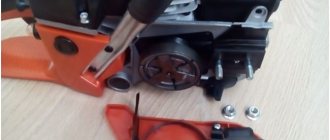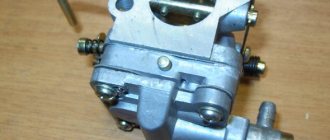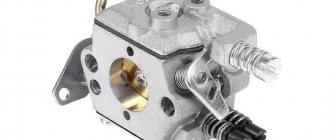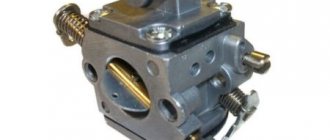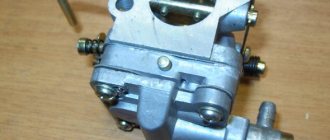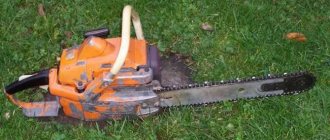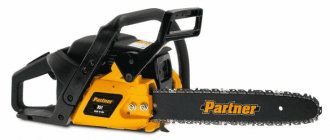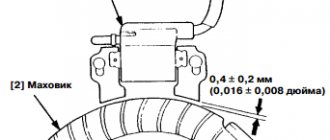Adjusting the chainsaw carburetor
The quality and performance of your chainsaw depends on many factors, but today we will talk about carburetor malfunctions. A lot depends on the operation of this node, including your good mood. You picked up the chainsaw, but it didn’t start, or it started and started sneezing and shooting, while completely losing power. Your day is ruined, and in your head there are thoughts about what is the reason, where to look for a repairman and how much the repair will cost.
Chainsaw spare parts
However, you shouldn’t despair in advance; most carburetor malfunctions can be corrected with your own hands, or adjustments can be made in a neighbor’s garage.
Taking care of yourself: safety precautions
- work in protective glasses and gloves;
- Make sure that at the moment of launching, the sharp parts are not directed at you or your assistants, and do not touch any body parts;
- do not disassemble the device while it is working;
- if it is not possible to independently determine the cause of the malfunction, seek help from professionals;
- do not disassemble the carburetor unless absolutely necessary, and if you do this, then film the process. Then it will be easier for you to reassemble the unit in reverse order.
When disassembling the chainsaw (if necessary), act very carefully, beware of cutting elements, they can leave deep wounds on the skin
Basic faults
If you've ever been interested in the design of a carburetor, you couldn't help but notice that all the holes on the assembly are extremely small. Even minor contamination caused by poor quality fuel can result in improper fuel or air circulation. Yes, there are filters installed on the inlet and outlet ports, but they do not always cope with their task. What does this lead to? Any mechanic will tell you the consequences.
The main malfunctions of a chainsaw due to the carburetor:
- Gasoline consumption has increased, thick black smoke is pouring out of the exhaust pipe, there is a lot of burning and soot around;
- The engine starts, but sneezes and shoots into the carburetor;
- The engine has lost power, the chainsaw no longer “drags”;
- You couldn't start your chainsaw;
- It is impossible to achieve normal operation of the engine: the speed fluctuates all the time;
- The chainsaw stalls immediately after starting, or when you sharply press the accelerator trigger;
As you can see, troubles from a faulty carburetor are guaranteed. Moreover, without disassembling the unit and its subsequent adjustment, they are unlikely to be eliminated. Therefore, it makes sense to take a closer look at the carburetor design.
It also happens: why the saw does not want to work
It is not always possible to make the chainsaw work normally by just adjusting the Calm carburetor. Sometimes the cause of the problem lies in something completely different. The following table will help you understand what exactly:
| Symptoms of a problem | Cause of the problem | What to do |
| The equipment constantly turns off, operation is not stable | The fuel is diluted with water. Fuel does not meet quality requirements | Change fuel |
| Spark power is insufficient | Replace spark plug | |
| There is little air in the fuel going to the engine | Change fuel | |
| The candle holder is acting up or not working at all | Change the candle holder | |
| No compression | Repair the motor | |
| Acrid black smoke pours out of the exhaust pipe | There is too much air in the fuel | Change fuel |
| Air filter is too old | Change the air filter to a new one | |
| There is white color in the exhaust smoke | There is too much oil in the fuel | Change fuel |
| No smoke is emitted at all | There is no oil liquid in the fuel | Change fuel |
| The device does not turn on | Old gasoline | Change fuel |
| The spark plug is out of order | Take out the candle and dry it | |
| The candle holder and the central cable do not work | Replace parts with new ones | |
| The ignition unit works every once in a while | Repair or replace the item with a new one |
Carburetor design
In this short review, we will not be able to describe in detail all the details of the carburetor and thoroughly familiarize ourselves with all the nuances of its operation, but we will dwell only on the main points.
The device of a carburetor on a chainsaw
The carburetor consists of the following components:
- Tube with air damper. A small wind tunnel that is designed to regulate the flow of air. The cross flap, depending on its position, reduces or increases the amount of air, leaning or enriching the fuel mixture;
- Diffuser. Made in the form of a narrowing at the end of the wind tunnel. The main task is to increase the pressure and speed of air when mixing it with fuel;
- Nozzle or sprayer. Designed to supply fuel and mix it with oxygen.
- Float chamber. A special tank that ensures a stable level of gasoline at the entrance to the air channel.
The principle of operation of the carburetor
Most often, problems with the carburetor can be fixed with your own hands. However, to do this you need to understand the basic principles of its operation.
The principle of operation of the carburetor
Carburetor operating principle:
- After starting the engine, the damper opens, through which air enters the carburetor;
- A zone of reduced pressure is created in the air wind tunnel and float chamber, causing air to be sucked through the diffuser;
- The intensity of air flow varies depending on the position in which the damper is set;
- At this time, gasoline flows from the chainsaw tank into the diffuser, where it mixes with air;
- A so-called air-fuel mixture is formed, which is directed through the intake channels directly into the combustion chamber;
Carburetor adjustment period
Before picking up a wrench and a screwdriver, let's understand in what cases the operation of a chainsaw can be improved by adjusting the carburetor.
Carburetor adjustment is necessary if:
- Worn or damaged adjustment screws. The reason for this may be either a manufacturing defect or the vibration that accompanies the operation of the chainsaw. With this malfunction, it is possible to adjust the carburetor without removing it from the chainsaw;
- The most common cause of carburetor malfunction is contamination. The fault for this lies with the owner of the unit. Obviously, the owner did not pay enough attention to cleaning and maintaining the air filter, and even turned a blind eye to the quality of the fuel. In this case, you can’t get rid of it with just one adjustment. Now you will have to completely disassemble the assembly, blow out all the channels, wash it, remove scale and scale, and then assemble and adjust it;
Cleaning the air filter
- A new chainsaw does not need adjustment. However, over time, serious wear and tear occurs on all components, including the engine. Your chainsaw has begun to work poorly at high speeds and under load. Factory settings no longer help. In this case, you can adjust the carburetor according to other parameters, however, this is a temporary solution, one way or another it is necessary to repair the engine;
Chinese models
Adjusting the carburetor of a Chinese chainsaw, for example, Carver, is carried out in almost the same way as factory models. There are the same three main adjustment screws L, N, T. Sometimes such models have the ability to adjust the idle speed. But as a rule, employees of specialized services and owners of such saws claim that it is not always possible to set up a high-quality Chinese chainsaw right away.
For classic Chinese models, screw L should be loosened 1.5 turns from the maximum value. Screw H must be loosened one revolution from the maximum. Idle speed is adjusted in the same way.
Thus, self-adjustment of a chainsaw carburetor is not a very complicated process and can, in most cases, be done by a self-taught person.
Originally posted 2018-07-04 08:33:34.
Carburetor adjustment
As we have already mentioned, the manufacturer sets fairly precise settings at which your chainsaw should work well. However, during operation, individual components and parts wear out and factory settings are violated.
Moving any of the adjusting screws even a quarter turn can lead to quite unpleasant consequences.
If you notice that the chainsaw is malfunctioning, has lost power, and often stalls for no apparent reason: it’s time to adjust the carburetor.
Carburetor adjustment screws
The process of adjusting a Chinese chainsaw is carried out by manipulating three screws: H (High), L (Low) and T. Screw T, depending on where and who made your chainsaw, may be marked S or LA.
- High: regulates the operation of the chainsaw at high speeds, is responsible for the operation of the main jet;
- Low: responsible for the operation of the engine at low speeds, responsible for the idle jet;
- T (S, LA): this screw is used to adjust the optimal idle speed level;
When starting to adjust the carburetor, find the chainsaw passport with a table of rotation angles of the adjusting screws. Adjustment can be made with a special or regular flat-head screwdriver.
Step-by-step instructions for adjusting the carburetor:
- Place the chainsaw in a well-lit room or open area;
- The next stage depends on the chainsaw. On some models, adjustments can be made without removing the air filter protective cover. Other manufacturers cover the screws with a cover that must be removed;
- We begin the main stage of adjustment by manipulating screws H and L. Tighten them until they stop. When you feel resistance, turn it back one and a half turns;
- Try starting the engine. If it does not start, achieve the desired result by turning screw T clockwise, no more than ¼ turn;
Thus, we have found the starting parameters to begin adjustment.
- After starting the engine, let it warm up for 8-11 minutes;
- Using screw L, find the highest engine speed and unscrew the screw from this point ¼ turn. If you have a tachometer, this operation is best carried out with its help;
- Use the idle screw (T) to ensure normal operation of the chainsaw at idle speed;
- Check the throttle response of the engine, drive it in different modes;
- If the breakdown could not be fixed at home, then you will have to contact an experienced mechanic who has not only knowledge, but also experience;
Above is the process for adjusting the most common carburetors that are installed on Chinese-made chainsaws. The adjustment process for some branded chainsaws may differ more insignificantly.
If possible, expensive devices should be repaired in specialized workshops.
Is disassembly necessary?
You can adjust the carburetor of a chainsaw without any disassembly at all; in rare exceptions, you only have to remove the air filter cover. There is a considerable amount of contradiction here: on the one hand, the chainsaw is designed for unhindered access to the adjustment mechanism, on the other hand, it is recommended to access it as little as possible.
True, experienced fellers and sawers always carry a flat-head screwdriver with a long blade and periodically adjust the carburetor. This is explained simply: during the manufacture of a chainsaw, its carburetor undergoes rough adjustments designed for a certain composition of air and fuel. It is clear that the conditions at the work site are different from those on the bench.
When changing the brand of gasoline or, for example, increasing air humidity, an experienced chainsaw user will always adjust the quality of the mixture for greater performance and less wear on the piston part. But this, we repeat, requires considerable experience in working with a specific chainsaw and knowledge of the peculiarities of its behavior. In addition, the adjustment is incredibly fine - the screws are tightened by only 1/10...1/20 of a turn.
Another reason for adjustment is carburetor repair or replacement. In any case, adjustment of the mixture quality should be carried out only if the serviceability of the carburetor is reliably known (no debris, gaskets are not poisoned), the air filter is clean, the spark plug, clutch and ignition system are in perfect order. Otherwise, there is a high probability that the malfunction will be eliminated in a moment and the adjustment will suddenly become incorrect, and the engine will begin to wear out.

